by Lisa Cooke | Nov 10, 2015 | 01 What's New, Ancestry, Beginner, Collaborate, Trees
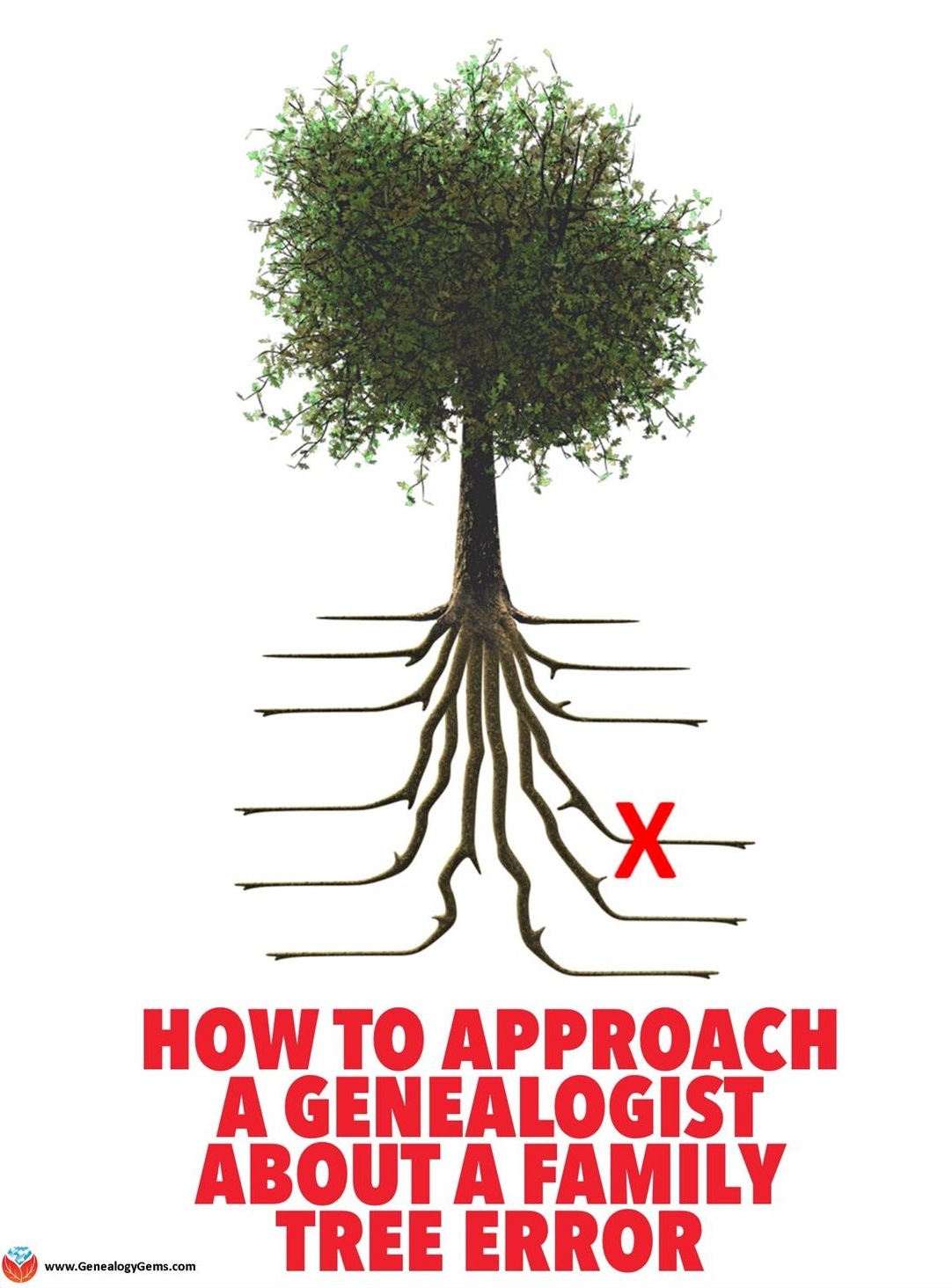
Is someone else’s Ancestry family tree causing a pain in your own tree trunk? Here’s a way to approach it–nicely!
Scott is a new Genealogy Gems listener and he recently dropped me a line about a problem that just a few–ok, nearly every–genealogist has at some point come face-to-face with: an error on an Ancestry family tree. Scott writes:
family tree. Scott writes:
“I recently found your podcast and have been listening with great interest. I really appreciate your experienced, informed, yet common sense approach to genealogy. Because of this common sense approach, I felt you would be a great source of advice for a dilemma I am having.”
This Genealogy Gems listener went on to describe coming across a family tree in the Ancestry forest that included his family line. It featured good research that mirrored his own and some additional that gave him hints that lead to even more branch extensions. “The only problem is, there is a critical error in her research: the starting point that she uses for that whole line is incorrect.”
Scott believes he has very good documentation and support for his claim. In fact he notes that she even has a document attached to her tree that supports his case that she has made an error.
“My dilemma: How do I appropriately connect with her to let her know that she has made an error? This individual has made a concerted effort to research and cite, and does it better than almost all the others on that line have done. I want to let her know so she can dedicate and direct those wonderful skills in the right direction, but I want to do it in a considerate way. Everyone makes mistakes of this nature – I sure have!! What is the best way to make an initial contact that exposes an error?”
If you participate in Ancestry’s online family trees then you have probably faced an Ancestry tree error. Let’s be honest: Genealogists can grow quite cynical about the intentions of others when they see so many trees lacking sources, and errors within trees. It’s frustrating to run into. Interestingly, in Scott’s description of his situation he’s already demonstrated the approach I would  recommend. Here’s what I told him:
recommend. Here’s what I told him:
- You’ve assumed the best (not the worst) about her approach to the research
- You want to help
- You know that everyone makes mistakes
I would weave that into the following approach that I like to take with any situation, genealogical or otherwise, where I need to approach someone about incorrect work:
1. Start with a compliment.
“I’m so impressed by all the work you have clearly accomplished so far….”
2. Address the problem by assuming that they are ultimately interested in accuracy.
“I wanted to make you aware of something I found which I believe changes the conclusions about this particular family line. I think you’ll find this as interesting as I did….” This approach, by the way, doesn’t say ‘I’m right, you’re wrong’ but rather it says the facts and data are right and you’re guessing they will be as interested in the facts as you are.
3. End with a sincere compliment or expression of appreciation
“Again, I’m so grateful that you have shared your tree online and I look forward to hearing from you”
And finally, when addressing an error on an Ancestry family tree, as with all things in life, we have to manage our expectations. If you don’t hear back, or get a negative response, just know that the other researcher may be emotionally invested in their findings in a way you’re not aware of, or may no longer be actively working on it, and not have time to revisit it right now. (For all we know, their spouse could have just gone into the hospital.)
Bottom line: An error on an Ancestry family tree is a pain in the tree trunk. Focus on placing your accurate tree online, fully cite your sources, and move on, knowing that you are offering other researchers who come across both trees an alternative.
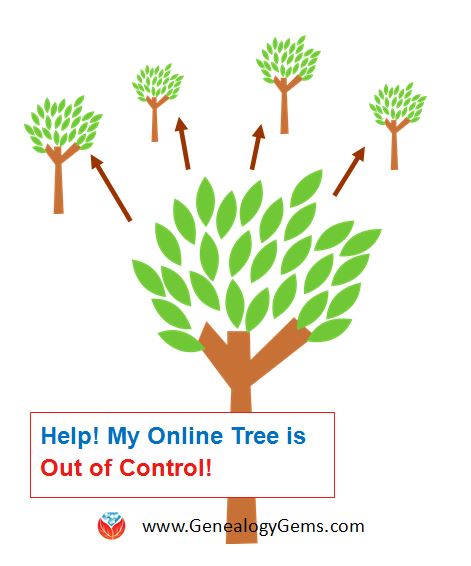 More Resources for Your Family Tree
More Resources for Your Family Tree
Disclosure: This article contains affiliate links and Genealogy Gems will be compensated if you make a purchase after clicking on these links (at no additional cost to you). Thank you for supporting Genealogy Gems!
by Lisa Cooke | Sep 20, 2017 | 01 What's New, Conferences, RootsTech
RootsTech 2018 registration is open! Travel plan alert: you won’t want to miss Wednesday, February 28, the new official opening day. Wednesday is all about technology, and it’s aimed at all of us (not just the techie crowd). We are a little bit giddy at the thought. Here’s our “first look” at what to expect for RootsTech 2018.
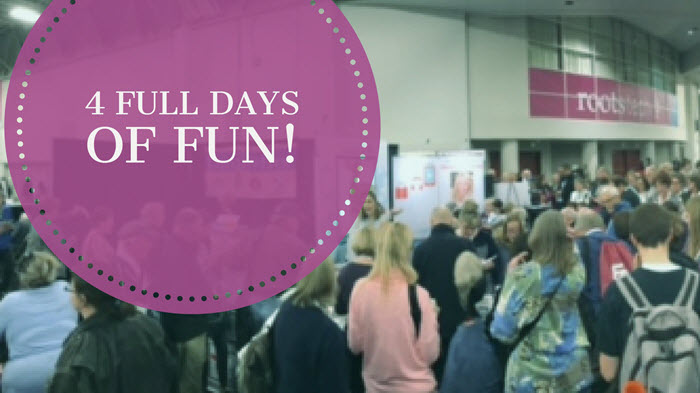
The buzz has already begun for RootsTech 2018! Here’s our synopsis of what’s going to be great about RootsTech 2018:
RootsTech 2018: “Connect. Belong”
Where: Salt Lake City, Utah
When: Wednesday, February 28 – Saturday, March 3, 2018
Hosted by: FamilySearch.org
Registration: Register online ASAP for early-bird pricing
RootsTech 2018: Don’t Miss Wednesday!
Technology day for everyone

Big news: RootsTech 2018 will run for four full days! The dates to mark on your calendar are Wednesday, February 28 – Saturday, March 3. Don’t miss the first day! In the past, Wednesday technology sessions have been targeted at industry movers-and-shakers. This year, Wednesday is still all about technology, but the day’s events have been expanded and broadened for all audiences. There will be an opening General Keynote Session, a new Innovation Showcase, and classes that will appeal to all audiences.
The Innovation Showcase has replaced previous year’s competition. It looks more like a high-tech “show and tell” of even more of the best-and-brightest stars in family history technology. Companies from around the world–from small startups to large organizations–will have a shot at presenting their newest product or service on stage before a large online and in-person audience. The audience will select a “People’s Choice award” via live text voting. (Click here by October 15 to nominate a product or service.)
Wednesday Expo Hall Preview
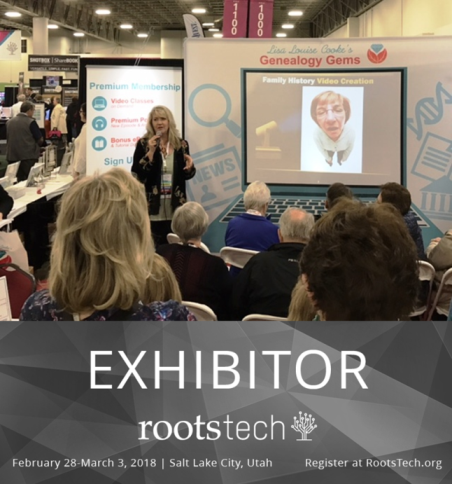 Make plans to come say hello to us on Wednesday evening at the Expo Hall Preview from 6:00 – 8:00 pm. Genealogy Gems will be there with another ultimate Exhibitor Hall experience (click here to get an idea of what’s coming). The Expo Hall is a stunning, not-to-miss experience, whether you love the energy of the crowd, the glamorous displays, or the chance to talk one-on-one with people from your favorite genealogy companies and services.
Make plans to come say hello to us on Wednesday evening at the Expo Hall Preview from 6:00 – 8:00 pm. Genealogy Gems will be there with another ultimate Exhibitor Hall experience (click here to get an idea of what’s coming). The Expo Hall is a stunning, not-to-miss experience, whether you love the energy of the crowd, the glamorous displays, or the chance to talk one-on-one with people from your favorite genealogy companies and services.
RootsTech 2018 Registration: Plan Early for the Best Experience
In addition to what’s new, many great RootsTech traditions promise to continue this year: expect dazzling keynotes, over 300 official RootsTech classes, and world-class evening entertainment. (Click here to watch my 2017 “Genealogy Giants” RootsTech lecture or click here for the recently-released 2017 keynote by LaVar Burton.) More details about this year’s keynotes and performers will be announced in the coming months, so check back with us often. We are official RootsTech Ambassadors and we’ll have the inside scoop on all the latest information and updates.
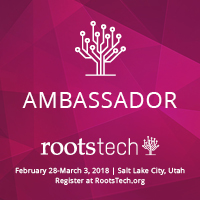 RootsTech registration is now open! There are lots of registration options–from a free Family Discovery Day experience on Saturday to a budget-friendly “Getting Started” four-day pass ($69 early-bird price) to the full RootsTech Pass ($169 early-bird price). Click here for a comparison of what each pass offers. And here’s a tip from a RootsTech veteran: Make your hotel reservations early! Those downtown hotels fill up so quickly.
RootsTech registration is now open! There are lots of registration options–from a free Family Discovery Day experience on Saturday to a budget-friendly “Getting Started” four-day pass ($69 early-bird price) to the full RootsTech Pass ($169 early-bird price). Click here for a comparison of what each pass offers. And here’s a tip from a RootsTech veteran: Make your hotel reservations early! Those downtown hotels fill up so quickly.
Going to RootsTech for the first time? Click here for a RootsTech Q&A with Lisa Louise Cooke.
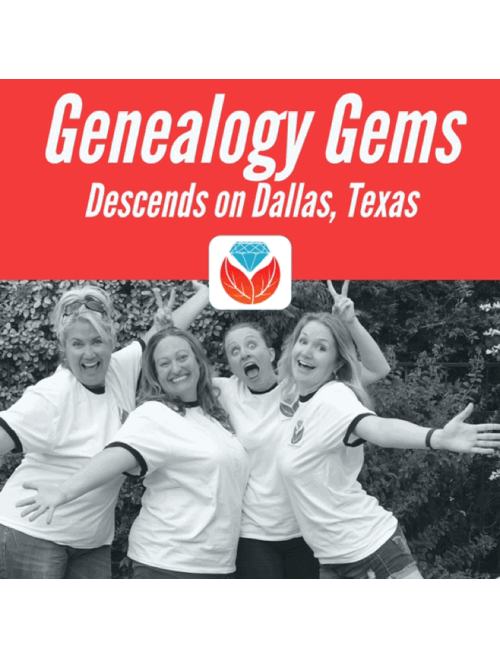
The Genealogy Gems team can’t wait to see you at RootsTech 2018!
by Lisa Cooke | May 24, 2017 | 01 What's New, Book Club, Writing Family History
Wish you could write family history like a master storyteller? Take a page from best-selling novelist Fannie Flagg’s fiction-writing. These three steps will help you bring your ancestors’ stories to life, so that their stories become as compelling to your relatives as they are to you.
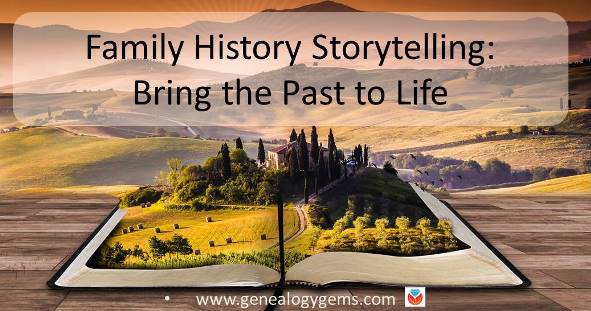
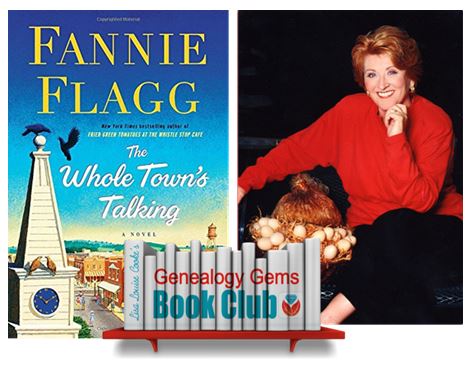 Powerful storytellers create characters so vivid, we miss them when we finish reading. They take us into worlds that become just as real. Experiencing their stories changes us, even if just subtly. Fannie Flagg is one of this generation’s great storytellers, and she does all three of these things in The Whole Town’s Talking, our current Genealogy Gems Book Club title. The book is an excellent example for family history storytellers who want to bring their own ancestors to life in narratives that captivate and change their own loved ones.
Powerful storytellers create characters so vivid, we miss them when we finish reading. They take us into worlds that become just as real. Experiencing their stories changes us, even if just subtly. Fannie Flagg is one of this generation’s great storytellers, and she does all three of these things in The Whole Town’s Talking, our current Genealogy Gems Book Club title. The book is an excellent example for family history storytellers who want to bring their own ancestors to life in narratives that captivate and change their own loved ones.
3 Keys to Amazing (Family History) Storytelling
1. Create vivid characters.
Lordor Nordstrom seems an unlikely hero at the beginning of The Whole Town’s Talking. He’s a 30-something single Swede who has come to the heartland of the U.S. to build a life. He’s a quiet man, a hard worker who starts a dairy farm. But then he starts to stand a little straighter and attract people his direction because he has a dream of what his world should look like. He places ads in newspapers and convinces other Swedes to settle nearby. Swedetown is born around him. We start to see that his quiet determination and vision are accomplishing great things for himself and others. Then this quiet, unprepossessing fellow gets up the nerve to place another newspaper ad:
Swedish man of 37 looking for Swedish lady for marriage. I have a house and cows.
But when he gets a response from a “24-year old Swedish lady of the Lutheran faith,” he starts to sweat and stammer and second-guess himself. He gets his picture taken: he looks like a hayseed. He gets a haircut: the bowl-cut style was a bad idea. But he persists despite feeling totally unready for the sweet, refined young lady who, after more stammering and shyness, eventually and very willingly becomes his bride.
NOW YOU TRY IT:
Think of an ancestor you want to write about. What do you know about him or her? Do you know she was born in a tiny village, or that he lost three siblings at once in a cholera epidemic? Do you know he was the first in the family to learn to read? Or that her husband disappeared when she had three children and one on the way?
You have to pay close attention to historical records to notice those kinds of details. You also have to think about and make connections between different events. That’s how you’ll realize those three siblings all died at the same time, and that not long after, he left school to take care of his family. Then you can start to create a “character” out of those scrawled names and details in all those old records.
Write down 5-10 specific details you know about an ancestor. If you can’t think of any, start scrutinizing historical records. Note physical details in military records or passport applications. Did he naturalize? Could she read English? How old were they when they married? Construct a timeline and make connections: “Oh my, he lost his wife in childbirth at the same time his father died. Suddenly he was caring for both his 82-year old mother and a newborn!”
2. Paint the historical backdrop.
Fannie places the story of Lordor and his want-ad bride Katrina in the beautiful but largely unknown American Midwest. The future of that country was as unwritten as the future of this couple. Gradually a small immigrant town comes into being, content to be its modest, friendly self. Fannie tells us about Main Street, the local businesses, the churches, the town’s main families and how they are related. We get just enough gossip to feel we know the people. In fact, we can imagine ourselves stopping in to gossip over a fence or attend a church potluck. The things that happen to the characters are more imaginable because we can picture the setting.
The story of Lordor and Katrina doesn’t just unfold against the settling of the Midwest frontier, though. As the narrator, Fannie Flagg puts Lordor and Katrina’s marriage into historical context, too. They were like many mail-order couples during a period of great change and movement in American history, she says:
On both sides, it was a desperate game of chance. But, surprisingly, many marriages did work out, and the results helped populate the country with a hardy and adventurous stock. People were willing to travel anywhere, sacrifice anything, to own their own land, to be free and be independent.
Though Fannie is writing fiction, she’s writing within a real historical world that she researches and loves to bring to life.
NOW YOU TRY IT:
We, too, can paint detailed portraits of our ancestors’ lives on a broader canvas of history. Do some reading about the history of the town and region. Look for trends or patterns or events that would specifically have affected your ancestors, based on where they lived, their ethnic or religious identity, financial status, gender, etc.
Click here to read more tips for learning the history surrounding your ancestors’ lives: Tell Your Ancestor’s Story: Use Social History for Genealogy
3. Give readers something to think about, or a reason this story matters.
The title of this story–The Whole Town’s Talking– doesn’t just refer to neighborly gossip on the streets and church pews of Swedetown (which eventually becomes Elmwood Springs). The key to this story is what happens at the town cemetery, on a hill overlooking the town on land donated by Lordor. After town residents die, we meet them again when they “wake up” in their cemetery plots. They still have their memories and personalities. They banter with each other and fawn over loved ones who come to visit their graves. They keep up on town gossip and their grandchildren and changes in society as best they can.
What I took away from this delightful scenario is the idea that family love persists past the grave. That memories of loved ones we honor at a cemetery may just be powerful enough to keep them there and, in a sense, alive. That they continue on.
NOW YOU TRY IT:
It’s not always easy to find a running theme, meaning, or message in a life you’ve researched. After all, you don’t see the whole thing. And most lives don’t unfold along a single theme. But if you’re excited enough to write about an ancestor, something about their story moves you. What is it? Try to put your finger on it. And then write about it, like this short passage about my own ancestor:
“What I see in Thomas Selby’s life is a man who never stopped moving or building. The challenges and opportunities of the frontier were to him an open door, beckoning to him. He started life with no apparent advantages, given away by his mother. That didn’t seem to dim his confidence. He was apparently uneducated, yet he studied law and argued a case before the Ohio supreme court. He bought up land and established friendships in southeast Ohio, then lit out for the California Gold Rush. He failed dramatically: the shipload of flour he took to sell the Goldrushers spoiled and he apparently had to walk all the way home. It took him seven years. But being broke didn’t stop him from buying homestead land in Missouri on the way home and immediately relocating his family. Eventually he settled there and spread his energies into creating enterprises: a flourishing farm, a general store, and judgeship.
I also see a man who seems to have totally excluded his wife and children when making decisions about the future. It was a common attitude for his time. But I think of him striding up to his yard on an evening seven years after disappearing, ragged and worn from the road. Family lore says he saw his wife come to the door with a gun and yelled, “Don’t shoot, Huldy, it’s me!” But if I were Huldy, finding out it was him–and that he’d just decided to move me into the wilderness without even consulting me–might just have made me pull the trigger.”
 For more storytelling inspiration, curl up with Fannie’s Flagg’s novel The Whole Town’s Talking–and then tune in to the upcoming Genealogy Gems Premium Podcast episode 148, in which Fannie herself joins us on the show. (Premium website membership required–but we play an excerpt in the free Genealogy Gems Podcast episode #204.
For more storytelling inspiration, curl up with Fannie’s Flagg’s novel The Whole Town’s Talking–and then tune in to the upcoming Genealogy Gems Premium Podcast episode 148, in which Fannie herself joins us on the show. (Premium website membership required–but we play an excerpt in the free Genealogy Gems Podcast episode #204.
family tree. Scott writes:
 recommend. Here’s what I told him:
recommend. Here’s what I told him: More Resources for Your Family Tree
More Resources for Your Family Tree



 Make plans to come say hello to us on Wednesday evening at the Expo Hall Preview from 6:00 – 8:00 pm. Genealogy Gems will be there with another ultimate Exhibitor Hall experience (
Make plans to come say hello to us on Wednesday evening at the Expo Hall Preview from 6:00 – 8:00 pm. Genealogy Gems will be there with another ultimate Exhibitor Hall experience ( RootsTech registration is now open! There are lots of registration options–from a free Family Discovery Day experience on Saturday to a budget-friendly “Getting Started” four-day pass ($69 early-bird price) to the full RootsTech Pass ($169 early-bird price).
RootsTech registration is now open! There are lots of registration options–from a free Family Discovery Day experience on Saturday to a budget-friendly “Getting Started” four-day pass ($69 early-bird price) to the full RootsTech Pass ($169 early-bird price). 


